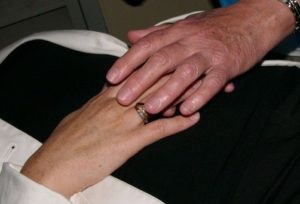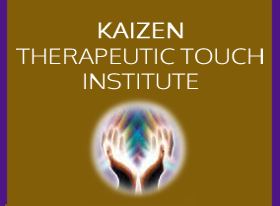 Therapeutic Touch® is widely recognized as a gift that eases pain and suffering, so common at end of life.
Therapeutic Touch® is widely recognized as a gift that eases pain and suffering, so common at end of life.
To understand and appreciate Therapeutic Touch as a helpful means of easing the experience of those dying, it is important perhaps to reflect on the end of life experience from the perspective of the dying; the context and the dynamic of that situation.
While each person’s end of life experience is unique there may be some underlying themes that are universal. A primary theme is the one of loss and its many associated emotions.
While loss is real, a lived experience made manifest through a loss of energy, loss of abilities, loss of control; the fear that accompanies this loss may have far graver consequences on the health of the person than the loss itself.
The fear of abandonment or fear of becoming a burden on family or community can lead to fear of resentment of others or rejection, and its offspring, vulnerability, expressed at times, in fear of being abused emotionally, mentally, physically, financially and spiritually. This fear of being abused may be totally ungrounded or it may, in fact, be based on past or active relationship dynamics and give rise to states of anxiety, depression, and pain.
This then is where Therapeutic Touch, as an energy healing modality can contribute.
The common effect of Therapeutic Touch is universally the same in every session. Marked by evoking a rapid relaxation response within two to four minutes of the start of the session, the Therapeutic Touch session alleviates or changes the perception of pain. This is noted, in scientific research and anecdotal experience, by a reduction in a request for painkillers; an enhanced sense of wellness with increased calm in the recipient and an enhanced ability to rest accelerating the healing process.
The intention of the Therapeutic Touch session is always the same – the practitioner’s intent is to move the healee’s vital energy field towards wholeness, harmony, and balance, no matter what their presenting condition.
The centering process, a foundational Therapeutic Touch practice, is essential for the practitioner to access the presenting information in the healee’s field during the Assessment phase. The practitioner’s sustained centering also protects them from picking up and holding any information received during the Rebalancing and Reassessment phase of the session and enables them to be “as an instrument of healing”. The practitioner’s own inner processes of rooting, emptying, centering in compassion, connecting, intentionality and attention are developed over time and with practice; all of which develops the “healer’s presence” of embodied compassion where, in fact, just in their being present can shift the atmosphere from one of stress and noise towards one of respect, deep quiet and peace.
The universal life force energy that is made available to the healee throughout the Therapeutic Touch intervention flows through the centered Therapeutic Touch practitioner and is not energy that is generated by them personally. It is through the Therapeutic Touch practitioner’s ongoing commitment to learning and personal growth that competency is developed…that competency being rooted in an understanding of effective and “therapeutic use of self”.
In Therapeutic Touch and in life, “we send what we are”. Much like the work of a professional actor, it is the quality and vibration of the inner state created by the practitioner, within herself, in response perceived in the healee’s field during the Assessment phase, that is transmitted and facilitates a deep inner bonding between compassionate and unattached practitioner and healee. The healee feels cared for, loved, perhaps like never before, and relaxes, opening up to the healing process.
Therapeutic Touch is particularly reliable in alleviating psychosomatic illnesses and dysfunctions of the lymphatic, circulatory and genitor-urinary systems, and has been widely recognized as invaluable in aiding terminal patients in a peaceful, final transition.
At end of life, it is often the fear of pain that may be greater than the pain itself. A five to 20-minute Therapeutic Touch session can change all that and bestow upon the dying a moment of grace; a quiet time to breathe more deeply and be present to themselves and their experience, in the moment. This is the gift of Therapeutic Touch!
It is the Therapeutic Touch practitioner’s ability to be compassionately present in the face of suffering – to be centered and unattached to outcome, simply there for the dying person, offering intentional, unconditional healing support through the application of the Therapeutic Touch session, that transforms fear into acceptance and appreciation for life as it is being lived in this moment.
While the dying person may not have the capacity to mobilize inner resources to resume day to day life, experience shows that they can have a healing effect that ripples out, in great waves of peace and appreciation, to those gathered near.
As Dolores Krieger points out, the major prerequisite the Therapeutic Touch practitioner must provide is a stable ego. The practitioner’s ability to sustain center for the duration of a healing session in the face of suffering at end of life is essential. And in so doing, the Therapeutic Touch practitioner cultivates an engaged and healing presence and the ability to create and sustain an interior state of deep, enduring inner peace, strength, order and balance.
Therapeutic Touch is recognized both as a mindfulness practice and as a meditation in action. Achieving competency in Therapeutic Touch requires training, practice and continuing education and self-reflection. It is experiential in nature.
A basic Therapeutic Touch session consists of three phases: Assessment, Rebalancing, and Reassessment although it quickly, with practice, becomes non-linear. The practitioner responding in the moment to what emerges in the “field” of the healee.
The vital energy field of a dying person is quite different from that of a newborn, a pregnant woman, an athlete or people with any other health condition. It is much more thin and tenuous in nature and quality. The Therapeutic Touch practitioner who works with the dying develops a special sensitivity that is both compassionate and unattached. The result of a healing session is always beyond the control of the practitioner and having accepted this fact, the practitioner can focus their moment to moment attention on being fully present to the healee.
What may be perceived in the healee’s field during the Assessment phase of a session is unique to each session as the energy field is in continual, dynamic flux. Each practitioner has their own very unique means of perception, processing information received in their unique, individual ways. Vital energy field imbalances may be registered as:
- Breaks or discontinuities of the flow of energy
- Too much energy (hyperactive areas) or too little (energy depletion)
- Pressure or fullness
- Congestion, blockages or sluggishness of energy flow
- Variations in rhythm; random pulsations
- Differences in temperature
- Inner messages or intuitive/direct knowledge perceived about the healee’s condition.
The Rebalancing phase of a session follows the Assessment phase. The experienced Therapeutic Touch practitioner, mindful of their role, the beauty of the healee, and the honour and privilege it is to offer support and help, is guided by the “field” to facilitate its movement towards health, wholeness, harmony and balance.
It is this unattachment to outcome, that enables the Therapeutic Touch practitioner to remain centered in compassion, aware of their role in facilitating the healee’s coming into “right relationship” with themselves and their experience. While a healing response may have been activated with the first introduction and expressed in the initial relaxation response, 2-4 minutes into a session, it is in the rest period that follows a Therapeutic Touch session where whatever healing the healee’s system is ready for, will occur.
As Dolores Krieger said, “We don’t stop at our skins. Once you understand that,
you begin to realize that relationships are something different than we think they are…You now look at all animate beings as completely different experiences from what your culture taught you to expect. You know that your human energies are constantly and dynamically interacting with the vital energy fields of others.”
References:
Krieger, Dolores, The Therapeutic Touch – Inner Workbook: Santa Fe: Bear & Co., 1997
Krieger, Dolores, Accepting Your Power to Heal: The Personal Practice of Therapeutic Touch, Santa Fe: Bear & Co. 1993
Krieger, Dolores, Therapeutic Touch as Transpersonal Healing, New York: Lantern Books, 2002






Dear Julia,
Thank you for the most enlightened and informative post. As a practitioner in training, what I learned in Level 3 is the importance of "Compassion with Intention". It can 'break through' the most 'stubborn' barriers that are put up metaphorically by protecting old wounds, fear or simply the unknown. The end result is both benefits to both healer and healee. The Universe keeps on giving time and time again, available to be drawn of and freely given by nature. My thoughts! Thank you for being such a great resource of wisdom and teacher!